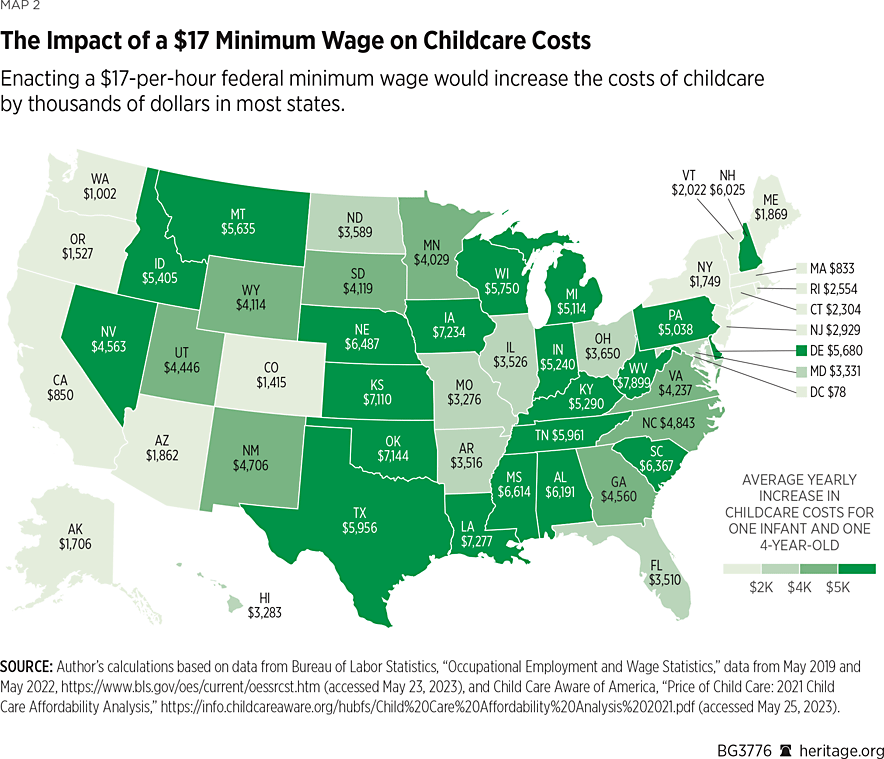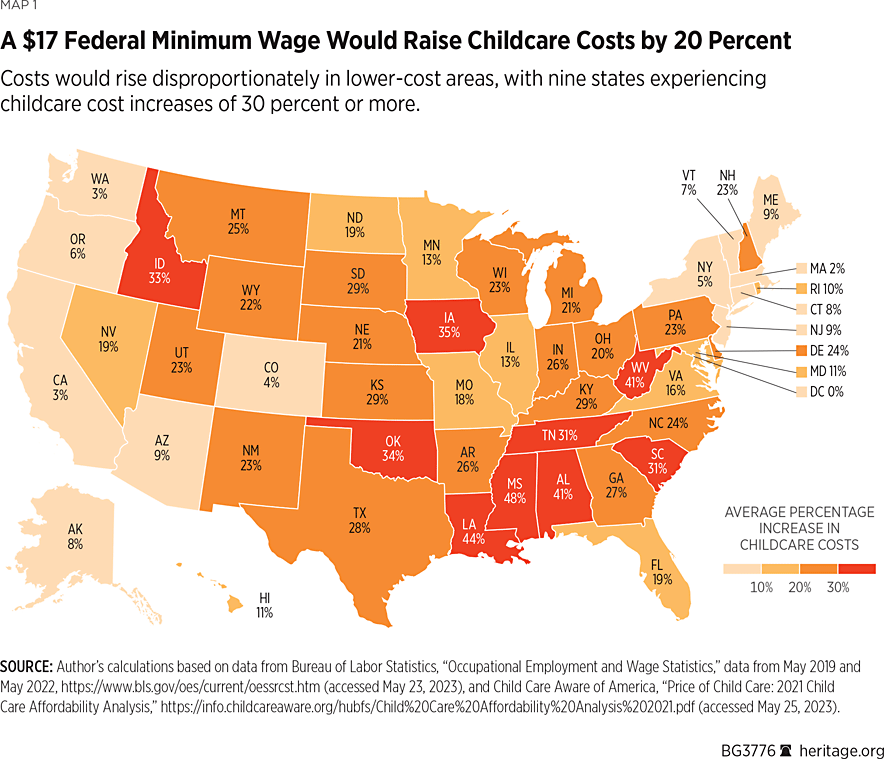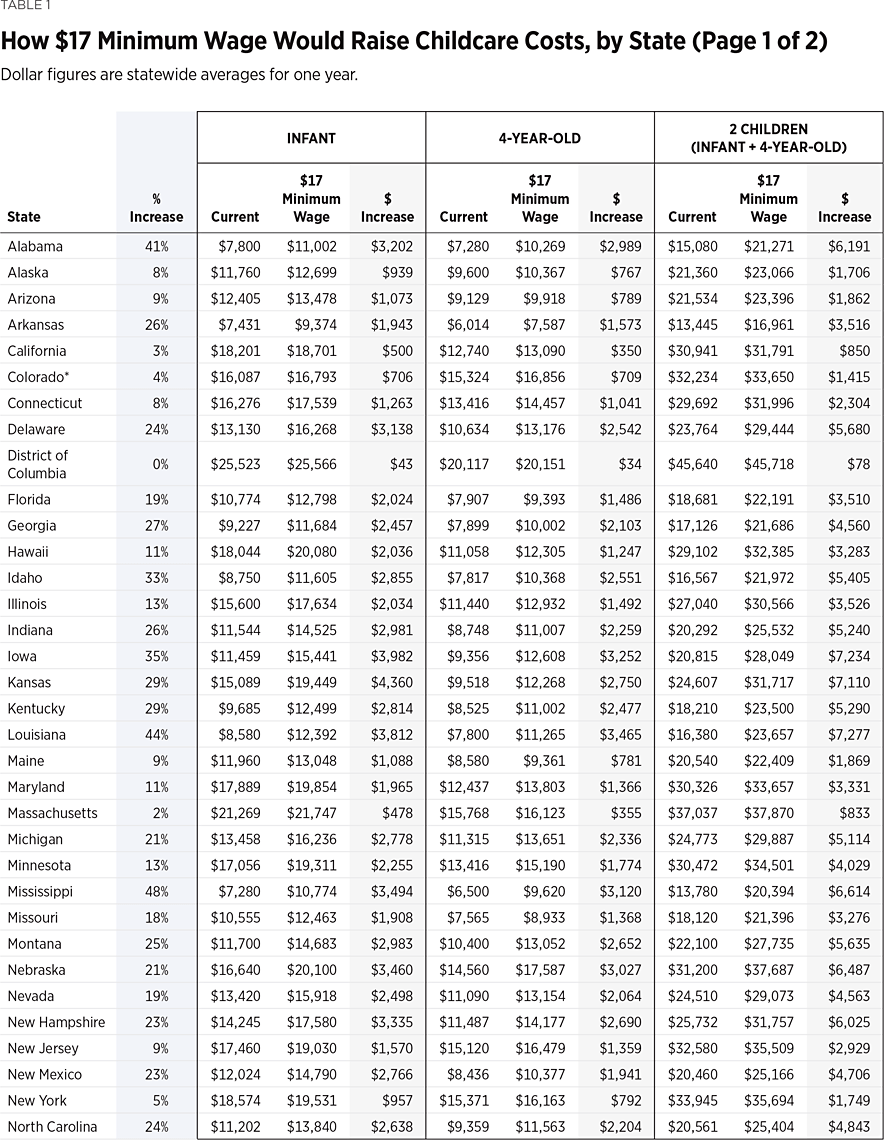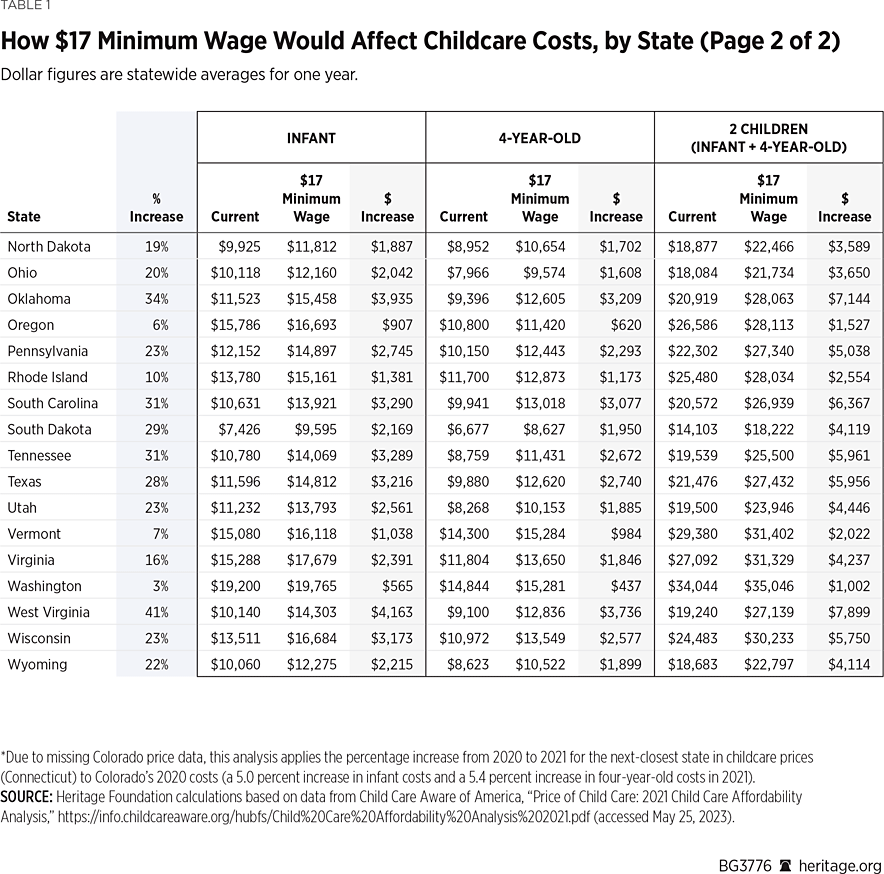The past three years have demonstrated to Americans that wage increases are only helpful if they exceed inflation. In many ways, policymakers’ responses to the COVID-19 pandemic—driving up demand through massive spending while simultaneously restricting the supply of workers by offering excessive welfare-without-work benefits—acted like a minimum-wage increase.
Increased demand and fewer willing workers meant that employers had to increase wages—in many cities, $15 per hour became a de facto minimum wage—and when employers had to pay workers more for the exact same output, they had to increase their prices. The end result has been that workers have experienced above-average wage gains and, yet, they are worse off because their paychecks do not buy as much as they used to. Over the past two years, the average worker has received a $4,300 pay increase, but inflation has eroded $7,000 of value, leaving him $2,700 poorer.REF
As federal policymakers consider implementing a steep increase in the federal minimum wage, they must consider the possible unintended consequences of imposing a one-size-fits-all minimum wage across 50 economically diverse states. Imposing a $17-per-hour minimum wage in Mississippi is equivalent to imposing a $39-per-hour minimum wage in Washington, DC.REF
In addition to job losses, an immediate impact of an artificially high minimum wage will be higher prices for many goods and services. Childcare will be particularly affected because it is a labor-intense service, and childcare workers’ wages and childcare providers’ profits are low.
Using data on childcare workers’ wages across the 50 states and regulations restricting childcare providers’ ability to reduce costs, the analysis in this Backgrounder estimates that a $17 federal minimum wage would raise the cost of childcare by an average of 20 percent across the U.S., adding $4,185 per year in childcare costs for a family with two children.REF The impacts would be greatest in lower-cost areas; in Alabama, Louisiana, Mississippi, and West Virginia, costs would surge between 41 percent and 48 percent. High-cost areas like California, the District of Columbia, Massachusetts, and Washington State would experience much smaller impacts, with price increases below 3 percent.
With childcare consuming even more of family budgets—40 percent or more of the median household incomes for families with two children in many states—families could be priced out of the childcare market completely.REF In turn, the unintended consequences of a $17 minimum wage could force some parents who want to work out of the labor force and lead to lower household incomes. Households that have only one parent and must use childcare would be more likely to turn to non-licensed, typically illegal, childcare. Moreover, childcare jobs would be lost, even as employment among “childcare workers” (as classified by the Bureau of Labor Statistics occupational titles), declined by 18.2 percent between 2019 and 2022.REF
While not all parents want or need full-time childcare, a $17 minimum wage could also hurt families who use only part-time childcare or even occasional babysitters, as it would apply to all types of childcare. For example, a family who currently pays $10 per hour for 10 hours of after-school care per week would face an extra $70 per week—$3,640 per year in added costs. Moreover, because federal law requires individuals who are paid more than $2,600 a year by a household to be treated as domestic employees, any household that employs a babysitter for more than 153 hours a year—the equivalent of three hours a week—would have to treat that babysitter as an employee, making the household subject to significant labor laws, tax withholding, and reporting requirements. By pushing more individuals over the household employee income threshold, a $17 minimum wage would make even limited and flexible childcare more costly and difficult to obtain.
Policies that help workers to achieve higher incomes without imposing unintended consequences on others—such as increasing educational opportunities, reducing barriers to businesses investing in workers, and keeping doors open to income opportunities for all workers—are far better strategies.
Moreover, while childcare is expensive, policymakers can help more families to find the care they need, from the provider they want, at a cost they can afford, by easing regulations on childcare providers, providing parents with options for public childcare dollars, eliminating barriers to employer-provided childcare, and making it easier for parents to save for childcare. And for all families—whether they use childcare or not—reduced government spending with lower and broader-based taxes can empower parents to make the choices that they desire for their families.
Childcare Costs and Economics
The average cost of full-time, center-based childcare for an infant was $13,382 per year in 2021,REF and the cost for a four-year-old was $10,746, bringing the total cost for two children to $20,152 per year.REF For a household with two median earners, childcare for two children consumed 19 percent of income in 2021.REF Childcare costs vary significantly across the U.S., however, due to differences in the cost of living as well as the impact of childcare regulations, such as teacher-to-child ratios and education requirements for childcare providers. Childcare for two children—an infant and four-year-old—range from a low of $13,445 in Arkansas to a high of $37,037 in Massachusetts (and $45,640 in the District of Columbia).REF
Childcare is expensive because it is labor-intensive. One individual can safely and effectively care for only a limited number of children, and technology provides little room for improving childcare workers’ capacity. That is, robots cannot care for children. Childcare regulations and licensing standards, which are predominantly state-based, are largely responsible for determining the cost of childcare. Regulations determine everything from teacher-to-child ratios, fire-safety standards, and square-footage-to-child ratios, down to the minutia of which type of toys can, cannot, or must be offered, and which beverages and snacks can, cannot, or must be offered, how they must be stored and labeled, and at which intervals they must be given. Moreover, childcare workers must have very specific qualifications, require background checks, and providers often must arrange and pay for continuing education.
Whereas some businesses—such as restaurants and retailers—can respond to minimum-wage hikes by reducing their workforce, shortening employee shifts, cutting back on facilities and equipment, or automating jobs, the nature of childcare work and strict childcare regulations leave little room for childcare centers to adjust to cost increases. A childcare provider’s only viable option is to pass the wage increases on to families in the form of higher prices. For providers in high-cost areas that are already paying near or above $17 per hour, the impact would be relatively small—but for providers in low-cost areas, costs could increase tremendously.
Estimated Cost Increases
Mandating that all childcare workers receive at least $17 per hour would result in significant cost increases for childcare providers. With childcare regulations limiting childcare providers’ ability to reduce other expenditures, higher costs would be passed on to families through significant childcare price increases.
The median wage for childcare workers across the U.S. was $13.54 per hour in 2022.REF Mississippi had the lowest median wage of $9.83 while Massachusetts had the highest at $18.30. With only two states (Massachusetts and California) plus the District of Columbia having median childcare wages of $17 or more per hour, a $17 minimum wage would require the overwhelming majority of childcare workers to receive significant wage increases. Using wage distribution data from the Bureau of Labor Statistics’ Occupational Employment Statistics, I estimate that a $17 minimum wage would require an average increase of 29 percent in the wages of childcare workers across the 50 states.REF
A breakdown of childcare provider costs from the Center for American Progress estimates that employee costs account for between 60 percent and 80 percent of childcare providers’ operating expenses.REF Wages likely consume an even higher share of in-home providers’ expenses and virtually the entirety of the cost of employing a nanny. Assuming that wages account for 70 percent of childcare providers’ expenses, the average percentage increase in center-based childcare costs across the states would equal 20 percent. This would bring the average cost of infant care from $13,144 to $15,444, and the average cost of care for a four-year-old from $10,562 to $12,447.REF

Although 20 percent is the average cost increase, families would be affected very differently across the country. Those living in low-cost areas would experience very large increases, while a few very-high-cost areas would be relatively unaffected. In Mississippi, where the median childcare wage is $9.83 per hour, costs would increase by 48 percent, but in Massachusetts, where the median childcare wage is $18.30, costs would increase by only 2 percent. In general, Southern and Midwestern states would experience the largest percentage cost increases while those in the Northeast and on the West Coast would experience the lowest—though still significant—cost increases.

On average, childcare costs for parents with two children (an infant and a four-year-old) would increase by $4,185, from $23,706 to $27,891.
Four states and the District of Columbia would experience cost increases of less than $1,500 per year for two children: DC (+$78), Massachusetts (+$833), California (+$850), Washington (+$1,002), and Colorado (+$1,415).
On the other hand, costs would rise by more than $6,000 per year for families with two children in 10 states: New Hampshire (+$6,025), Alabama (+$6,191), South Carolina (+$6,367), Nebraska (+$6,487), and Mississippi (+$6,614), Kansas (+$7,110), Oklahoma (+7,144), Iowa (+$7,234), Louisiana (+$7,277) and West Virginia (+$7,899). These cost increases represent a large portion of families’ budgets.
The median household income in the United States was $70,784 in 2021.REF With a 20 percent increase in costs, childcare for an infant would consume 22 percent of a median household’s income, childcare for a four-year-old would consume 18 percent of income, and childcare for two children would consume 39 percent of the median household income.


Such large increases in the cost of childcare could prevent many families from affording it. That could reduce employment by causing some parents—particularly within two-parent families—to drop out of the labor force. Other families may have no option than to use non-licensed or illegal childcare or to depend on unpaid childcare of friends and family. Moreover, seemingly unaffordable childcare could deter couples from having children or from having as many children as they would like. This is an important consideration in light of U.S. fertility rates dropping below the replacement rate of 2.1 births per woman to fewer than 1.7 births per woman in 2020 and 2021.REF
These estimates only consider the cost of raising wages that are currently below $17 per hour to $17. In reality, a $17 minimum wage would push the wages of many childcare workers well above $17 because providers would have to pay more experienced childcare workers and those with greater responsibilities more than the minimum-wage workers. A study by the Federal Reserve Bank of St. Louis estimated that a minimum-wage hike would increase childcare costs by an amount equal to the increase from the current median childcare wage up to the new minimum wage.REF Applying this metric, bringing the median childcare wage from $13.54 to $17 would result in a 25.6 percent increase in the cost of childcare, as opposed to the conservative estimate of a 20 percent increase.
Real Solutions for Raising Incomes
Incomes rise when workers produce more value, which comes through education, experience, and technology that makes people more productive. When the economy was strong and employers had to compete for workers—including investing in substantial education and training for inexperienced workers—low-income wages rose substantially. Between 2016 and 2019, the wages of workers at the 10th percentile (those making about $10 to $11 per hour) increased by an average of 3 percent per year after inflation, which was roughly 2.5 times the gains for median and high-income earners.REF
Those gains came without negative consequences and benefited individuals and the economy at large because they were the result of people producing more instead of them being paid more to produce the same amount.
A 2022 economic analysis by David Abraham and Simcha Barkai highlighted the periods of 2016 to 2019 and the 1990s as periods of significant declines in the share of low-wage workers in the U.S.REF In analyzing the causes of the decline in low-wage workers (defined as those making less than $15 per hour, inflation-adjusted) from 41 percent of all workers in 1985 to 28 percent in 2019, the authors examined the impact of education and minimum-wage laws. They found that increased education attainment accounts for much, but not all, of the declining share of low-wage workers.
Contrary to the goal of higher minimum-wage laws, the authors found that states that had lower minimum wages (below $10 per hour) experienced a greater decline in their share of low-wage workers than states with higher minimum wages.REF The authors write that their results show that “low wages are no more common and no more persistent than in the past and therefore proposed policies should not be justified on the grounds of worsening economic conditions for low-wage workers.”REF
In contrast to the significant real wage gains that accrued to low-wage workers between 2016 and 2019, the more recent wage gains caused by excessive federal spending and work disincentives (which functioned like increases in minimum wages) led to high inflation that erased most workers’ wage gains. Between 2021 and 2023, the wages of workers at the 10th percentile increased by about 1.8 percent per year after inflation while the wages of all other workers declined in real, inflation-adjusted terms.
The recent, artificially induced wage increases have disproportionately led to price increases as opposed to job losses because the federal government inflated demand for goods and services with trillions of dollars in new spending and it restricted the supply of workers through excessive welfare-without-work benefits. As of May 2023, there are still 2.4 million fewer people employed than there would be if employment were at pre-pandemic rates.
However, with economic growth and job gains waning, the traditional consequences of minimum wage mandates will likely come back into play. According to the Congressional Budget Office, those consequences include job losses (particularly among younger, less-educated workers), lower total incomes, a smaller economy, and increased federal deficits and debt.REF
Instead of attempting to raise incomes artificially, policymakers should help workers to achieve real, lasting income gains. Empowering employers to develop and employ their own innovative apprenticeship programs would help workers to gain valuable skills without six-figure student-loan debts.REF Reducing costly and unnecessary regulations for businesses would free up resources to invest in workers. And keeping doors open to new and innovative sharing-economy and gig-economy platforms would increase income opportunities and expand entrepreneurial possibilities for workers at all levels.REF
Ways to Expand Accessible, Affordable Childcare
While the potential for reducing childcare costs is limited by the labor-intensive nature of childcare, there is much that policymakers—particularly at the state and local level, but also the federal level—can do to help more families find childcare that meets their needs at a cost they can afford.REF
State and local lawmakers should eliminate unnecessary regulations that increase costs without significantly improving child welfare.REF For example, it makes sense to require childcare providers to be trained in cardiopulmonary resuscitation (CPR), but it does not make sense to require all daycares to maintain a nursing-mothers roomREF or to mandate that all childcare providers—including mothers who watch a few kids in their home—obtain a bachelor’s degree.REF
State regulators also need to reduce barriers to less expensive in-home daycares and to informal childcare arrangements among friends, families, and neighbors.REF In 44 states it is illegal to watch children in one’s home (with the exception of limited circumstances) without having to undergo a costly and burdensome process to turn one’s home into a licensed childcare facility.REF This is presumably part of the reason why the number of small in-home providers has dropped by more than half between 2005 and 2017.REF Yet, in-home childcare is about 25 percent less expensive than center-based care, and in addition to often being more convenient and desirable for families, it is often the only viable option in rural areas.REF
Both state and federal lawmakers can help parents to achieve the childcare they desire by keeping doors open to flexible, independent work opportunities. Recent surveys show that a majority of parents’ top choice for childcare up to age four is to either have both parents work flexible jobs and share childcare responsibilities or to have one parent work a flexible job and use part-time care.REF While California enacted a law—AB5—that closes off independent work options that are especially valuable to parents, and while Democrats in Congress have proposed a super-sized version of California’s law in the Protecting the Right to Organize Act, a better way to reduce childcare costs and help more parents to achieve their top childcare preference is for Congress to codify an individual’s right to be in control of his work by creating a bright-line test across all federal law, clarifying that individuals who control their own work are independent contractors and not employees subject to employer control.
At the federal level, policymakers should expand affordable childcare options for low-income families by allowing those eligible to use Head Start funds for the provider of their choice.REF Particularly because Head Start provides very limited hours of care, allowing families to use Head Start dollars for private and nonprofit childcare providers could help lower-income working parents by enabling parents to choose childcare that better aligns with their needs and desires.REF
Moreover, federal policymakers could help to expand employers’ offering of onsite childcare by making a small change in the Fair Labor Standards Act to exclude childcare benefits from the “regular rate” of pay calculations, just as the law already excludes similar benefits, such as retirement contributions, and accident, health, and life insurance benefits.REF Finally, federal policymakers could help families to save and pay for childcare by allowing families to use 529 savings accounts for preschool and by enacting Universal Savings Accounts so that families can save for all purposes in a single, simple account.REF
Conclusion
Many families in America struggle to find childcare, especially at a cost they can afford and in a setting that meets their standards of what is best for their children. Excessive regulations on childcare providers restrict the number of providers—particularly small, in-home providers—and drive up its costs. Adding another substantial restriction—a 134 percent increase in the federal minimum wage to $17 per hour—would further drive up childcare costs by an estimated 20 percent across the states, adding $4,185 in costs for a family with two children. Families living in lower-cost areas in the South and Midwest would be hardest hit, with costs rising 30 percent or more in nine states. Accompanied by regulations that already restrict the supply and drive up the cost of childcare, a $17 minimum wage could make childcare unaffordable for millions of families.
Mandating a $17 federal minimum wage would increase incomes for some at the expense of lost jobs, lower incomes, and higher prices for many others. Instead of trying to artificially increase wages, policymakers should expand opportunities for workers in ways that help them to achieve real and lasting income gains without unintended consequences.
Childcare will never decline in costs in the same way that technology has enabled other costs to decline because childcare is a labor-intensive job, but there are ways that policymakers can help to make childcare more accessible and affordable. By easing unnecessary regulations on childcare providers, allowing parents to choose where to use public childcare dollars, and making it easier and less costly for parents to save for childcare costs, policymakers can help more families to find the care they need, in an environment they believe is best, and at a cost they can afford.
Rachel Greszler is a Senior Research Fellow in Economics, the Budget, and Entitlements in the Grover M. Hermann Center for the Federal Budget at The Heritage Foundation.
Appendix
Estimated Impact of $17 Federal Minimum Wage on Cost of Childcare Across U.S.
The analysis in this Backgrounder relies on the most recent May 2022 state-based occupational employment statistics from the Bureau of Labor Statistics.REF This includes 459,460 childcare workers who earn a median wage of $13.54 per hour. Compared to 2019, this marks an 18.2 percent decline in childcare employment and a 16.2 percent nominal increase and 1.9 percent real, inflation-adjusted increase in childcare wages. The data are broken down by state and territory and include wages at the 10th, 25th, 50th, 75th, and 90th percentiles.
To approximate wage distributions across childcare workers in each state, the analysis applies the 10th percentile wage to the first 12.5 percent of workers; applies the 25th percentile wage to the 12.51 percent through 37.5 percent of earners; applies the 50th percentile (the median wage) to the 37.51 percent through 62.5 percent of earners; applies the 75th percentile wage to the 62.51 percent through 87.5 percent of earners; and applies the 90th percentile wage to the 87.51 percent through 100 percent of earners. This approximation method results in total wages being 1.9 percent lower than the aggregate reported total, providing a relatively close match.REF
To estimate the additional wage costs of bringing the minimum wage up to $17 per hour, all reported deciles of wages that were below $17 were brought up to $17 per hour. This increases childcare worker wages (excluding additional FICA and other taxes) by an average of 29.4 percent across the U.S., with significant variance across the states. Wage increases averaged less than 10 percent in seven states plus the District of Columbia and were greater than 50 percent in four states.
Childcare tuition cost increases rely on estimated childcare costs for infants and four-year-olds across the states, as reported in Child Care Aware of America’s report, “Price of Care: 2021 Child Care Affordability Analysis.”REF Various estimates of childcare providers’ budgets assess wages and benefits as representing between 60 percent and 80 percent of providers’ total costs.REF Wages and benefits represent a very high portion of home-based childcare providers, and all of nanny costs. This analysis assumes that childcare workers’ wages represent 70 percent of childcare providers’ costs.
Childcare centers are highly regulated and have strict teacher-to-children ratios, leaving almost no room to reduce costs by laying off workers, reducing their hours, or cutting back on other likely mandated expenses. Thus, this analysis assumes that the entirety of the required wage increases will be passed on to families. With wages representing 70 percent of total childcare budgets, this analysis finds that childcare costs would increase by an average of 20 percent across the U.S. Variance among the states ranges from less than 5 percent in Washington and Massachusetts to 43 percent in Mississippi.
Limits of This Wage-Expansion Analysis
The childcare worker data exclude daycare and preschool administrators for whom the median wage was $24.94 per hour in 2022. Roughly 8 percent of these administrators make less than $17 per hour, and a $17 minimum wage would require wage increases for these workers, and upward pressure on other administrators’ wages.
As a Congressional Budget Office (CBO) analysis noted, this is a secondary effect of upward pressure for workers earning at, and moderately above, the new minimum wage. The CBO’s analysis, which looked at a $15 federal minimum wage, estimated that 17 million workers with wages below $15 per hour would be directly affected as well as another 10 million with wages slightly above $15 per hour would also be affected. The CBO reported that those effects would include both income gains and job and income losses.REF
This analysis only includes the direct effects of wage increases for childcare workers currently earning less than $17 per hour. Including the direct effects on daycare and preschool administrators’ wages, as well as the secondary wage effects (for both childcare workers and administrators) caused by childcare providers’ need to maintain a hierarchy of earnings to prevent losing more experienced and effective workers, would require even larger childcare wages and childcare cost increases than estimated in this Backgrounder.



